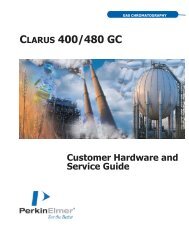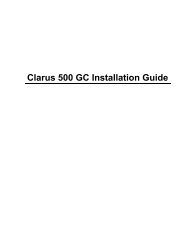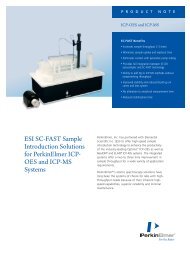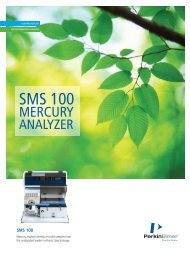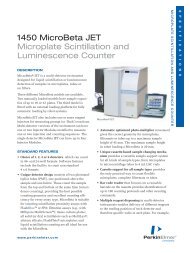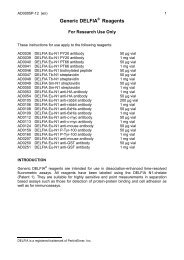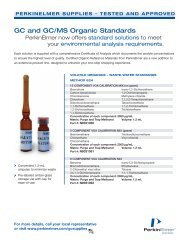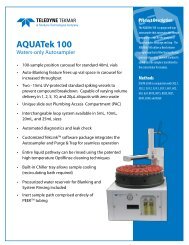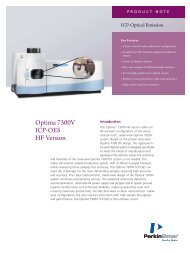HT Protein Charge Variant Kit User Guide - PerkinElmer
HT Protein Charge Variant Kit User Guide - PerkinElmer
HT Protein Charge Variant Kit User Guide - PerkinElmer
Create successful ePaper yourself
Turn your PDF publications into a flip-book with our unique Google optimized e-Paper software.
<strong>HT</strong> <strong>Protein</strong> <strong>Charge</strong> <strong>Variant</strong> <strong>Kit</strong> <strong>User</strong> <strong>Guide</strong><br />
Why is the resolution of charge variants in my sample so low?<br />
1. The pH of the Running<br />
Buffer may be too low:<br />
Increase the pH to<br />
improve resolution. Higher<br />
pH running buffer<br />
increases the migration<br />
time and allows better<br />
separation. The higher pH<br />
may require the use of a<br />
longer assay time. See<br />
the Optimization of<br />
Running Buffer pH section<br />
for more detail. If the resolution is not sufficient at the highest pH of the Running Buffer system, then the<br />
pI of the sample is most likely outside the allowed range.<br />
2. Excipients or contaminants may be co-migrating with or affecting the migration of charge variants: Desalt<br />
the sample to remove any excipients that may interfere with or alter the profile. If the <strong>HT</strong> <strong>Protein</strong><br />
Express, <strong>HT</strong> Pico <strong>Protein</strong>, or <strong>HT</strong> Glycan Profiling assay was run before the <strong>HT</strong> <strong>Protein</strong> <strong>Charge</strong> <strong>Variant</strong><br />
assay, then clean the electrodes with molecular biology-grade water.<br />
How can I eliminate carryover, if it is greater than<br />
0.5%?<br />
1. Desalt the sample: Samples that contain cell culture media<br />
or high concentrations of salt / excipients / amine-containing<br />
buffer can potentially increase carryover. Desalting the<br />
sample prior to labeling may reduce the carryover.<br />
2. Use a longer assay type: Longer assays are better at<br />
suppressing carryover.<br />
Why does the migration time of the same sample vary?<br />
The microchannels of the chip have a dynamic coating that suppresses electroosmotic flow during the<br />
separation; variation in the degree of coating causes variation in migration time. Typically, the migration time of a<br />
sample will vary by 0.5 - 2 seconds, with low pI samples having higher variability than high pI samples. Different<br />
chips, GXII instruments, and Running Buffer lots can contribute to the variability. Furthermore, the variability in<br />
migration time is typically lower for chips that have run more samples or have been stored with <strong>HT</strong> <strong>Protein</strong><br />
<strong>Charge</strong> <strong>Variant</strong> Storage Buffer for a longer time. Variation in migration time should not impact resolution or %<br />
relative amount reproducibility. When significant variation in migration time or abnormally slow migration (i. e.,<br />
when the free dye peak elutes after ~33 s) is observed, we recommend that the chip is washed two or three<br />
times with storage buffer and then stored overnight at room temperature, to regenerate the dynamic coating.<br />
_________________________________________________________________________________________<br />
Caliper - a <strong>PerkinElmer</strong> Company Page 12 of 18 PN: CLS135474 Rev. 02<br />
68 Elm Street<br />
Hopkinton, MA 01748-1668<br />
1-877-LABCHIP (1-877-522-2447)



